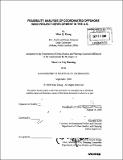Feasibility analysis of coordinated offshore wind project development in the U.S.
Author(s)
Zhang, Mimi Q
DownloadFull printable version (7.278Mb)
Other Contributors
Massachusetts Institute of Technology. Dept. of Urban Studies and Planning.
Advisor
Jonathan Raab.
Terms of use
Metadata
Show full item recordAbstract
Wind energy is one of the cleanest and most available resources in the world, and advancements in wind technology are making it more cost effective. Though wind power is rapidly developing in many regions, its variable nature creates obstacles in integrating significant amounts of wind power to the electric grid. One potential solution for reducing the fluctuating nature of wind power is to site wind projects in regions of complementing wind regimes to reduce variability. This thesis explores the feasibility of creating a coordinated network of offshore wind projects through examining its technological requirements, economic viability, and the policy and planning issues of building such a network in the U.S. Wind speed data for sites along the east coast of the U.S. are used to analyze the nature of offshore wind patterns and the benefits of interconnecting multiple wind projects. The main questions are: 1) Is an offshore wind network technologically feasible? 2) What are the costs and benefits of creating an offshore network with transmission lines? 3) What are potential ways to plan, permit, and develop such a network? An overview of research on existing turbine technology, turbine foundation technology, and transmission technology show that it is technically possible to build a network of offshore wind projects. An analysis of the costs and benefits of physical interconnection show that the cost savings from reduced variability pale in comparison to interconnection costs. It is more cost effective to coordinate the siting of all projects within the network, by connect the projects directly to the onshore grid as opposed to creating a separate, offshore grid for wind projects. The current planning process for offshore wind development permits projects on a site-by-site basis, so developing an entire network of sites with the goal of reducing variability would require an extensive stakeholder process where all relevant parties agree on a set of sites. A coordinated network could also be developed over time by incorporating variability as a priority in the permitting process.
Description
Thesis (M.C.P.)--Massachusetts Institute of Technology, Dept. of Urban Studies and Planning, 2008. Includes bibliographical references (p. 53-62).
Date issued
2008Department
Massachusetts Institute of Technology. Department of Urban Studies and PlanningPublisher
Massachusetts Institute of Technology
Keywords
Urban Studies and Planning.